The Topping E50 & L50 DAC and headphone amplifier offer up to DSD512 decoding as well as 3.5W of output power. They are priced at $269 & $229.
Disclaimer: The Topping Topping E50 DAC and L50 headphone amplifier sent to us is a sample in exchange for our honest opinion. We thank the team at Shenzhen Audio and Topping for giving us this opportunity.
To read more about Topping products we have reviewed on Headfonics click here.
Note, this 2-page review follows our new scoring guidelines for 2021 which you can read up on here.
Topping has been busy again with another release of compact desktop amps and DACs. This time they are focusing on the range just below their headline D and A series DACs and amps such as the A90 with the launch of the new E50 DSD512 and MQA capable balanced DAC as well as their new L50 balanced headphone amplifier.
Both the DAC and the headphone amplifier can be bought separately at $269 and $229 respectively but given their similar launch dates and product numbering we thought it would be a good idea to see how they pair together in this review.
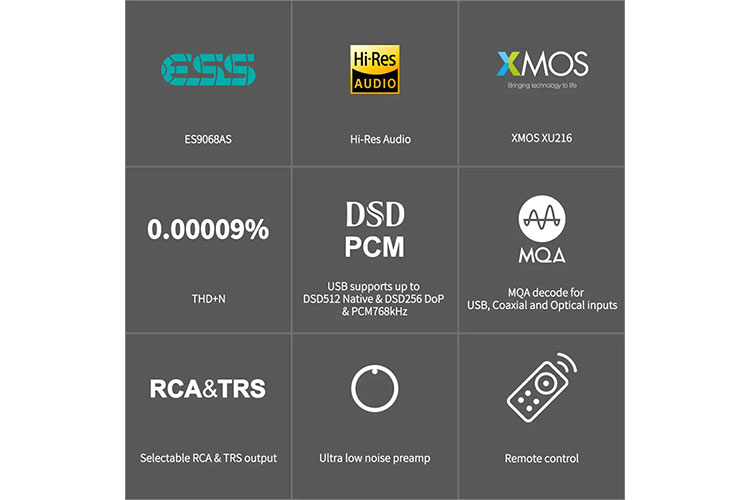
Tech Highlights
E50
Despite looking much like its smaller brother, the E30, the E50’s internals is very different. Firstly, it’s equipped with an ES9068AS DAC chip, with an XMOS XU216 USB controller. This combination allows the E50 to decode PCM streams up to 32bit/768kHz, DSD 512, and even MQA.
Aside from the DAC chip, the E50 also houses a CPLD to process the femtosecond clock signal to reduce jitter. In addition to that, the internal circuitry has been optimized to allow the E50 to have a diminishingly low 0.00009% THD, and a dynamic range of 126dB. This combination of measurements allows the E50 to accurately reproduce music.
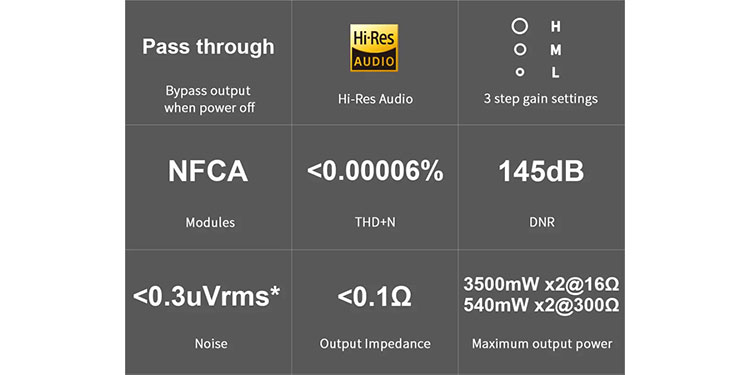
L50
The L50 on the other hand pushes the envelope on what Topping can do with their NFCA technology in their midrange offerings. Although all of the amplifiers in Topping’s current lineup are based on NFCA technology, the implementation on the L50 is closely associated with the implementation done on the A30 Pro.
This allows the L50 to have more power to push high impedance headphones while producing a THD+N of 0.000006% and a dynamic range of 145dB. With a rated impedance of <0.1Ω, the L50 will be a versatile amplifier that will stay away from influencing the impedance curves of headphones, while producing up to 3.5W into 16Ω, and 540mW into 300Ω.
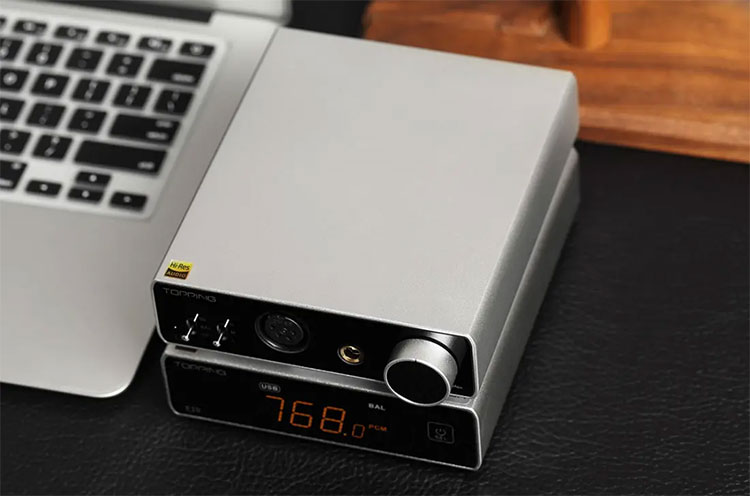
Design
With the E50 and L50, Topping takes most of the design cues from their E30 and L30. This time, the E50 and L50 are both much larger devices since they are designed to fit balanced inputs and outputs. So both the E50 and L50 have anodized aluminum chassis that comes in 4 colors, red, blue, black, or silver. We were sent the silver version of both devices.
E50
The front fascia of the E50 features a screen with a 7-segment display which is surrounded by other status displays for the input mode, output mode, and the file type currently being decoded. Right beside the screen, there is a solitary touch button that can be used to access the various options available on the DAC.
At the rear of the device, the left side contains the balanced outputs of the device. On the left of those outputs are the single-ended RCA outputs, then there are the standard digital input options, and a 5V power inlet which can be plugged into any 5V USB power supply.
L50
Being designed as a pure amplifier, the L50 doesn’t have anything in the way of digital displays. Instead, the front fascia has classic toggle switches that will turn on the different modes of the device. Then there are the headphone outputs and a volume knob which has just enough resistance to accurately dial in your desired volume.
The rear of the device on the other hand is made of matte-finished plastic that houses both the input and output options.
The rear of the L50 also accepts the power input, which is a standard barrel adaptor. However, the voltage is rated 15V AC. This means that it might be more difficult to replace the power supply on the L50 since it’s a transformer with a 15V output instead of the more ubiquitous switch mode power supply.
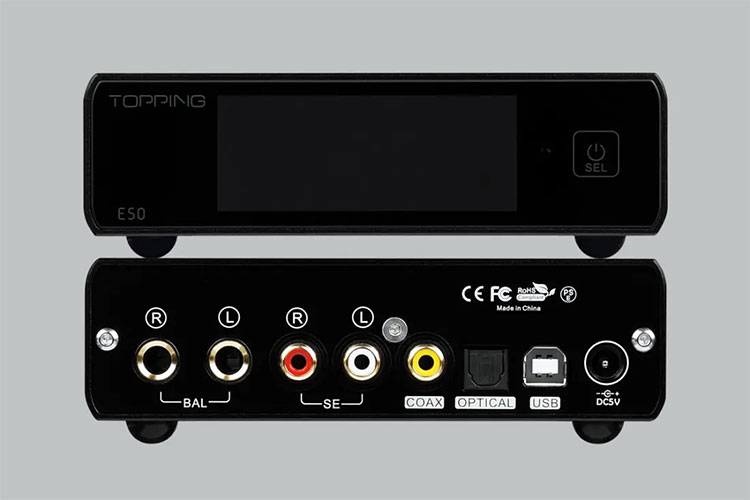
I/O
Looking at the E50 DAC, it has what you would expect in terms of the available input options. At the rear, it has USB, coaxial, and Toslink inputs.
However, there won’t be any wireless options that are becoming common among most modern DACs. The E50 has both balanced and single-ended outputs, however, the balanced ¼” TRS outputs on the E50 are a bit more difficult to find connections for.
Since the E50 and L50 are designed as a stack, the L50’s input perfectly matches the outputs available on the E50. So the L50 has a pair of standard RCA inputs and a pair of ¼” TRS inputs. Fortunately, Topping sells a pair of ¼” TRS interconnect cables separately, which would work perfectly with the E50/L50 stack.
The rear of the L50 has a pair of outputs, but they are just passthrough outputs. What’s more interesting with the L50 though is the firmware update port which is also located at the rear of the device.
In terms of headphone outputs, Topping has provided the L50 with a single-ended ¼” output and a 4-pin XLR output which is a very common connector for balanced desktop headphone setups.
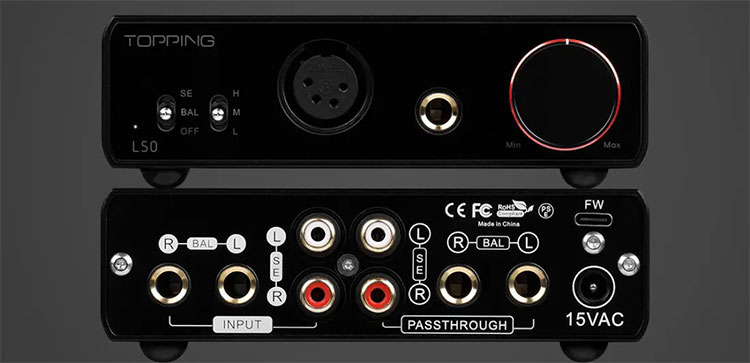
Controls
E50
The E50 has several options that can be accessed through the menu which can be accessed through the touch button or the remote control. To access the menu system using the touch button, the device must initially be unplugged, and then press and hold the touch button while turning on the E50.
This will go into the menu, and touching and holding it will either advance the menu or make a selection within the menu. The menu itself is made mostly of symbols, so those who are uninitiated will have a hard time deciphering the alpha-numeric code in Topping’s DACs.
Once the device is initialized, the screen will either show the output level if the E50 is in pre mode and the sampling rate if the E50 is in DAC mode. The touch button can only be used for input selection and holding it would put the E50 into standby mode. However, menu access can only be done using the dedicated buttons that are on the remote control.
With the remote control, there are dedicated buttons for power, input selection, line out mode, filter, brightness, and auto standby mode. What’s glaringly left out though is an option to toggle between pre-out and DAC mode.
Ultimately, I would have wanted to see a menu system that is more easily navigable to allow the user to change the settings without having to look at the user manual.
L50
The complementing amplifier to the E50, the L50, is a much simpler device since it doesn’t have any digital controls. Instead, the L50 has toggle switches, which allow the user to switch from power off, balanced or single-ended input. Then there’s a 3 level gain switch that complements the volume control to allow the volume knob to always have accurate tracking.
With the toggle switches and the analog controls, I believe the L50 is much more intuitive to use, allowing the user to simply use it right out of the box without consulting the manual too much.
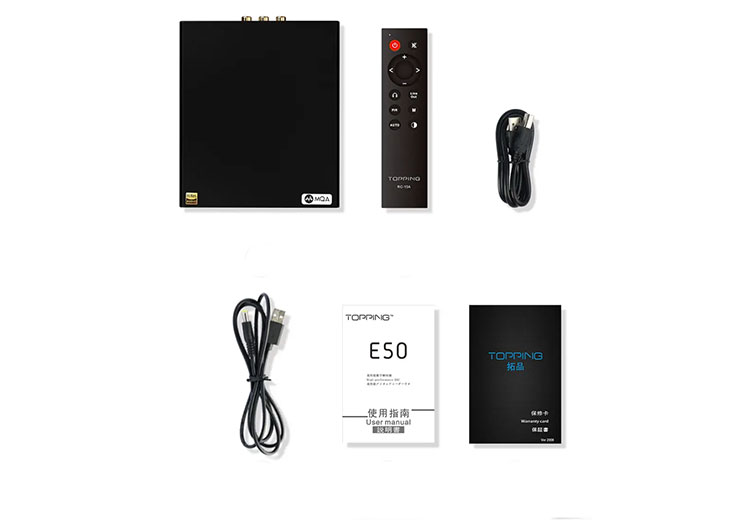
Packaging & Accessories
Both the E50 and L50 use Topping’s standard packaging, so it’s a white flip top box with foam inserts that keep the device and accessories safe.
With the E50, the package comes with the DAC itself, a remote control, a USB to barrel adaptor, and a USB A to USB B cable. However, there are 2 accessories that I would have wanted to see, the first is a power adaptor to make it more convenient for the user, and also a TRS to XLR converter which would make it easier to use existing XLR cables.
On the other hand, the accessories that came with the L50 are what I expect from any amplifier, which is just the power adaptor and a 3.5mm to ¼” adaptor. While this is what I typically expect at this price point. However, it would have been nice to be provided with a TRS to XLR converter.
Of course, if you’re buying them as a stack, buying a pair of TRS balanced interconnects from Topping is also a good option. It’s just that it’s not the most common connection that is used with audiophile balanced headphone systems.

Sound Impressions
E50
Summary
Although the E50 isn’t the last word in terms of accuracy, it maintains an overall relaxed presentation without being sterile. With a thick bass quality that depicts the overall scale and breadth of the recording while maintaining an accurate presentation while still being enjoyable.
Generally, the E50 does not editorialize on the music, instead, it stays away from injecting its own coloration. This allows the soundstage presentation to be accurate and natural while making details easily accessible, only stumbling in more complicated passages.
Timbre
On first listen, the most notable feature in the sound of the E50 is the bass response of the E50. Starting with the sub-bass region, there is a diffuse and spacious quality to the sub-bass extension, while lacking that last bit of palpability.
The mid-bass on the other hand has a thicker and almost solid quality. With drum hits, there is a good amount of heft, however, the decay structure of drum hits tend to linger a bit too long making successive drum hits sound more blurred together than they ought to be. With bass guitar grooves the flow becomes more groovy.
Interestingly, the thickness in the mid-bass presentation doesn’t bleed into the midrange. This results in an overall clear and accurate midrange presentation allowing male vocals to have a natural timbral quality. Female vocalists like Adele on the other hand retain the raspy and textured presentation, but there isn’t much in the way of embellishing the vocal textures of most female singers.
When listening to piano recordings such as ones done by Yiruma, the piano timbre is on the thinner side, but textures are presented well. With guitars, there is a good amount of crunch when they are strummed, but the acoustic cavity isn’t as well defined as I expected.
To stay away from sounding fatiguing, the treble presentation on the E50 isn’t too forced, but what keeps it from getting too relaxed is the fact that leading edges are still well defined. The decay in the treble notes on the other hand comes as soon as they appear, preventing notes from being too splashy ensuring that not much treble energy is left after cymbal hits.
Staging & Dynamics
Although the E50 cannot create the most expansive soundstage presentation, it manages to not get in the way of presenting the width of the soundstage. Imaging is well defined, while most images can be located accurately within the soundscape while staying away from being artificially being sharpened.
Where the E50 tends to fall short is the layering within the soundstage, as the images are formed mostly within 1 layer of the soundstage. Interestingly, the dynamic range capability of the E50 is impressive both on paper and through my listening tests, as the softer tones have a dainty quality while still managing looming crescendos just as readily.
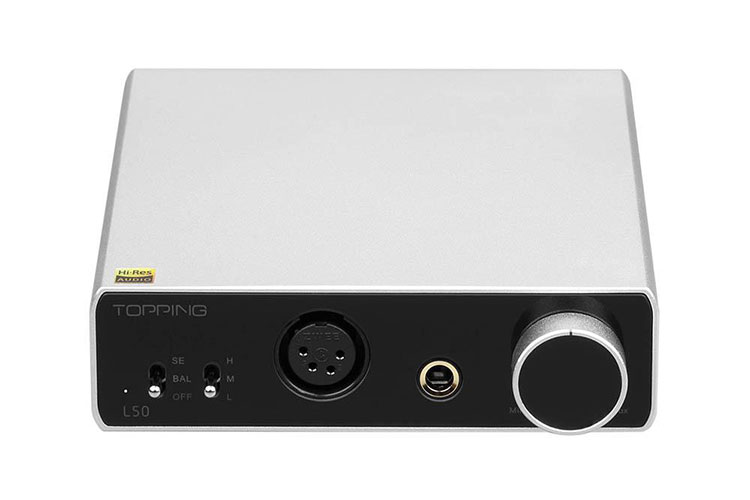
L50
Summary
Generally, the L50 has a thinner and more honest character, allowing most of the elements of the music to shine through easily. The vocal presentation may be on the thinner and drier side, however, this doesn’t translate to making it unengaging, as Topping has tuned the L50 to be more exciting without being congested.
Timbre
When listening to the L50 alone, it’s obvious that it can extend well into the sub-bass region. However, the sub-bass does not have a particularly expansive quality, instead, it has a more localized presentation making it sound like there is a subwoofer that emanates from the corner of the room. Thumps on drum skins sound natural and rounded, but textures could still be more fleshed out.
A common trait that the L50 shares with the E50 is that its midrange presentation leans towards a more honest presentation. This means that male vocals aren’t artificially induced with euphony, so the natural timbre of the voices of crooners such as Michael Buble or Josh Groban easily comes through. Comparatively, female vocals are drier giving them a less wispy quality than expected.
Conversely, I’m surprised to hear that instruments tend to be brought forward in the mix. Instruments such as pianos which aren’t typically as forward as the vocal range suddenly become more forward and euphonic. Guitars have a similar character, allowing strums to be crisp while each string can be made out easily.
I believe that part of the reason why instruments are more forward is because of the lower treble uptick that gives them a brighter harmonic tilt. This also bleeds into lower treble instruments such as percussion and wind instruments.
This gives cymbals a crystalline character while having just the right amount of decay to make cymbals sound natural. The treble extension on the L50 is neutral but extends well into the upper treble range.
Staging & Dynamics
Due to a well-extended treble region, the L50 easily depicts the space between the images within the soundstage. However, when it comes to casting the entirety of the soundscape, the L50 sounds a bit more closed in than usual.
The placement of images within the soundscape is fairly accurate, making the directionality of the images accurate without any artificial air. Surprisingly, there is some depth and the space between the images is proportional to the width of the images.
Click on page 2 below for synergy and select comparisons


